HALLPRINT’S REMARKABLE SA SUCCESS STORY & VOLUNTEER TAGGING
In this, the first instalment of a two-part story, David Hall explains the role a local company has played in fish tagging, both here, interstate and overseas.
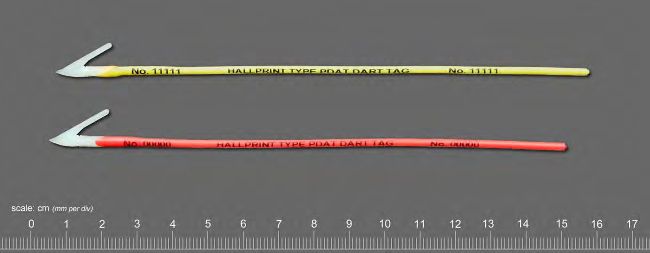
Hallprint’s world renowned dart tags used extensively on tuna
(type PDAT)
What were you doing on February 3, 1995? Perhaps you weren’t born yet? If you are old like myself, you may remember the Adelaide Crows AFL team was barely a few years old and yet to win its first Premiership. My good friend, Dean Brown AO, was Premier of SA, Paul Keating was Prime Minister of Australia, and the first ever fully animated feature film, Toy Story, was released.
On a personal front, I was well established in my role as SA Fisheries Director and my (now) late father Michael’s and my mother Wendy’s business Hallprint was by then a well-established supplier of external fish tags world-wide. On the same day an 81cm or roughly 12kg southern bluefin tuna was double tagged among many hundreds of others in the Great Australian Bight by then CSIRO technician Kevin Williams, along with CSIRO Fisheries Scientist Naomi Clear.
That little tuna lived its life to the full and was recaptured in September 2023 in Bass Strait, Victoria, as a 117 kg behemoth by recreational tuna fishos Andrew Seccull and Lachie O’Reilly. That's 10,452 days (28.5 years) ago, making it the second longest time at liberty for a tuna tagged by the CSIRO. The longest was a 135.4kg tagged southern bluefin tuna caught by a recreational tuna fisher in September 2022, also in Bass Strait, which was tagged in the Bight 29.5 years beforehand! At the time of writing this fish represented the longest time at liberty reported to us for any fish tagged with a Hallprint external tag, and quite possibly the longest anywhere in the world for any external tag. The record for any tag type is for an internal tag applied to a school shark tagged off NE Tassie in 1951, which was recaptured from the same area in 1986, some 34.5 years later.
What made this great catch even more significant for me is that the fish had two tags in it as part of a large-scale tagging program run by the CSIRO. The fact that the tuna was able to retain both tags in perfectly readable condition after such a long period is astounding. This is testament to both the skill of the tagger Kevin Williams and the quality of the tags, made by Hallprint. The founder and developer of Hallprint fish tags during the early to mid-1980s, my father Michael Hall, who sadly passed away in 2003, would be incredibly proud to know of this success, as indeed am I, as his successor in the business.
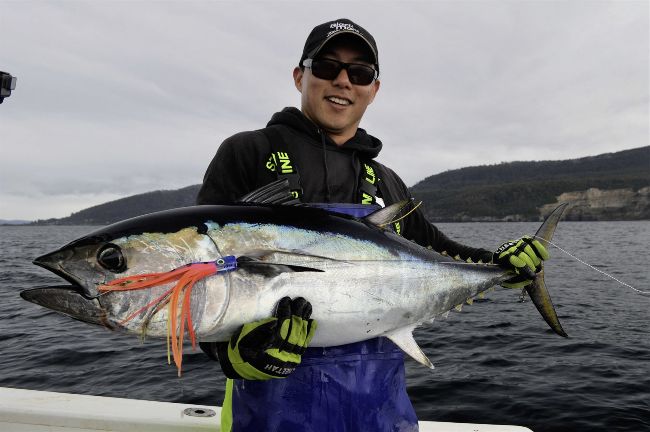
photo credit Jonah Yick, Tuna Champions Scientific Ambassador
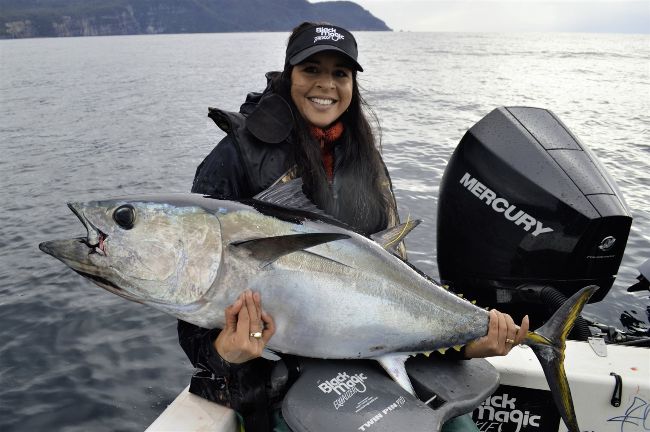
Jonah Yick and Devi Barker were out tagging SBT in Tasmania, while simultaneously collaborating with CSIRO scientists and recreational fishers in Victoria, to determine the significance of the 28.5 years-at-liberty, 117kg tagged SBT which was caught the day before. Coincidentally, this was the exact situation which occurred last year with the record breaking 29.5 years-at-liberty, 135.4kg tagged SBT!
The story of Hallprint making fish tags began during my time as a young graduate scientist at the SA Department of Fisheries in the early 1980s when I challenged my dad – who already had a successful label printing business – to come up with a better fish tagging solution that did not fall apart or become unreadable after a short time. The only tags available back then from the United States could not be relied upon to last much more than a year or two if you were lucky. I wanted tags that would last the lifetime of the fish I was tagging, and that was potentially 10 years or more.
I don’t think Dad or I in the early 1980s ever envisaged tags being found on recaptured fish in a fully readable state after 20 years at liberty, never mind 30 years. I would have been happy with five or six years, which was unachievable with the tags available at the time, according to my predecessors in the Fisheries Department who worked for a number of years tagging fish along the River Murray in SA. They told me that the only tags available globally fell apart or became unreadable after a year or two, and that I would need to find another method if I wanted long term data for my area of study, which back then was the Coorong Lagoon (mulloway, black bream and greenback flounder) and later snapper and King George whiting in the SA gulfs.
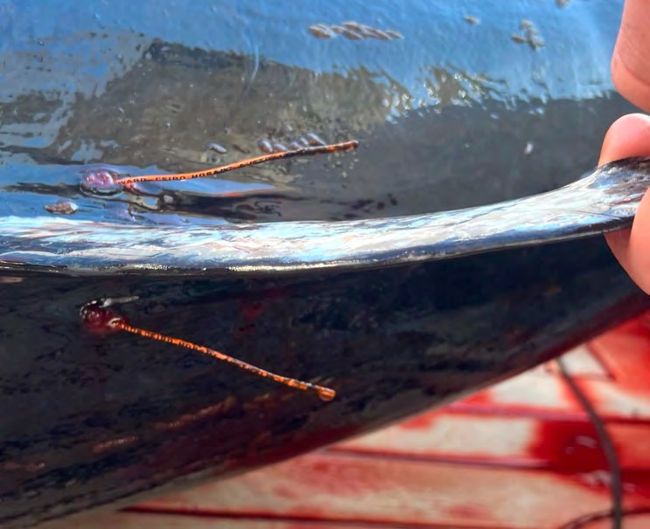
The two Hallprint dart tags on the 117 kg tuna still intact and readable after 28.5 years at liberty!
(photo credit Jonah Yick, Tuna Champions Scientific Ambassador)
Incredibly, from the one 1990s CSIRO tagging program on SBT alone, at the time of writing this piece in September 2024, there had been 44 reported recaptures of tuna that have been at liberty for 20 years or more. These tags were recovered from tuna recaptured from around south-eastern Australia and as far away as Indonesia, the mid Indian Ocean to South Africa and across the Tasman to New Zealand (Naomi Clear pers. comm.). Nearly all of these fish were originally tagged as juveniles in SA waters.
Hallprint is now globally dominant in its niche, exporting its range of external “conventional” tags to almost every country for use on aquatic animals, from abalone the size of your thumbnail to great white sharks and everything in between, including salmon, rock lobster and tuna to name a few; a peep at our catalogue will give you an idea.
My former background as a fisheries scientist and manager has obviously helped me run the company since Dad’s passing in 2003. In actual fact, we have gone from strength to strength, winning the Premier’s Small Business Export Award in 2016 and continuing to do well, despite competing new technologies and a big hit from COVID in 2020-2021. I strongly believe to be successful in business, or any organisation for that matter, as an owner and/ or director you need to be in the shoes of your customers to properly understand their needs.
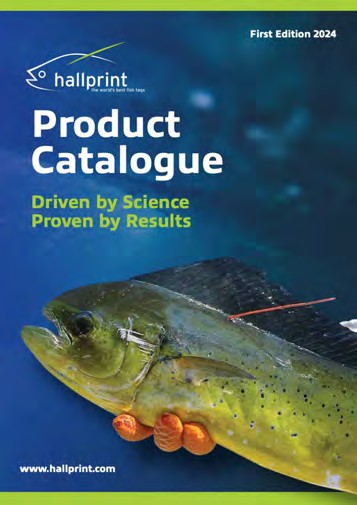
We now have an experienced fisheries scientist and former client Keith van den Broek as our North American agent, and manufacturing operations are still based in South Australia at Hindmarsh Valley. Things are overseen by long term General Manager Darren Evans (15 years at Hallprint) and Production Manager Julie Langmead (21 years at Hallprint) and their production team. This clearly shows that, with passion, belief, hard work, cleverness, diligence and sheer determination, South Aussies can still make the best stuff in the world when they want to.
The double tagged fish caught in September 2023 had received further treatment as it had been injected with a strontium chloride solution at the time it was tagged and released. Strontium chloride is a non-toxic salt that occurs naturally in sea water and results in a “mark” being laid down on the otoliths, or ear bones, of the fish. This is visible as a thin line in the otoliths when they are sectioned (cut in half) and viewed under an electron microscope. The otoliths continue to grow after the fish was tagged and released and, if 29 bands are counted after the strontium mark, just like growth rings on a tree trunk, the scientists will know that their method for ageing SBT is correct. This enabled CSIRO to validate the otolith ageing method for this species; these accurate age estimates are critically important to the setting of sustainable catch quotas and the international management of the species (Naomi Clear, CSIRO pers. comm.).
It would not have been possible to collect this rare and important fisheries research and management information without recreational fishers and scientists working together.
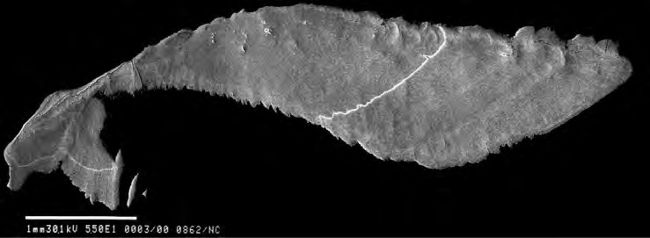
A sectioned otolith (ear bone) from a recaptured SBT showing the distinct line caused by a strontium chloride injection at the time of tagging, in this case three years before the subsequent recapture. Scientists can use such information to verify that the ageing work they have done on other tuna using growth rings has been accurate which has huge connotations for the management of the species
(photo credit: Naomi Clear CSIRO).
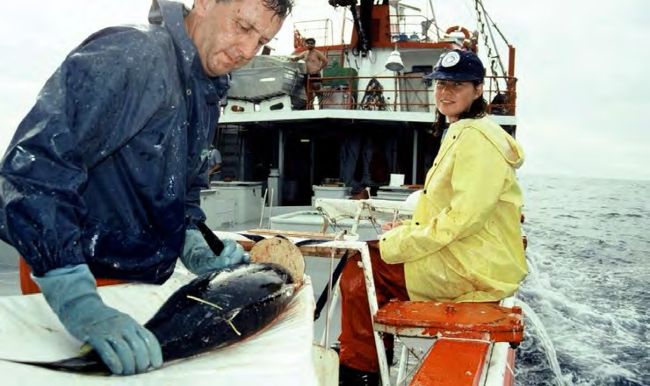
Kevin Williams and CSIRO Fisheries Scientist Naomi Clear onboard the Fina K in February 1995, the tagging trip on which the 117kg recaptured SBT was tagged as a 2-year-old!
(photo credit: Naomi Clear, CSIRO)